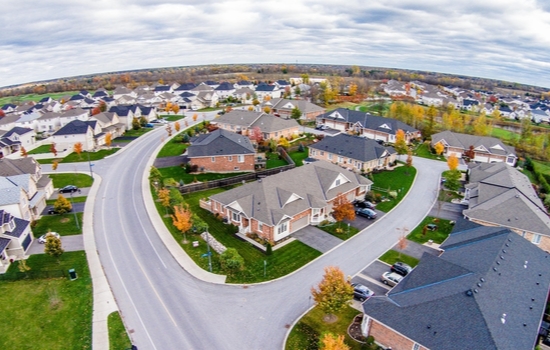Pricing your work is key to running a successful roofing business. However, many companies make one of two major mistakes when estimating a roofing job. One mistake is to undercharge the roofing job, which undercuts profitability and creates cash flow problems. The other error is overcharging the roofing job, which often leads to homeowners selecting a more reasonably priced competitor or being unable to pay for the job on time. Companies that are able to correctly and accurately estimate their roofing jobs close more deals, stay profitable more easily, and see consistent revenue growth.
How do you estimate a roofing job so that it reflects the true job cost and returns a profit? Here are a few key ways to calculate costs more accurately and find the right pricing for your jobs.

What method should you use to estimate a roofing job?
When it comes to creating a roofing estimate, there are multiple approaches to consider. Some contractors prefer building estimates from scratch using spreadsheets or Word documents, while others rely on specialized roofing software. The key is to discover the method that suits you and your business best and then become proficient in it.
How do you estimate a roofing job without under- or over-charging?
Start with the most accurate measurements
The first step to correctly pricing a roofing job is to accurately measure the roof. In the past, this was often a challenge for contractors, who had to climb on the roof, calculate the squares, and determine the pitch. But new aerial measurement technology takes the guesswork out of this process and gives contractors the most accurate numbers every time. By ordering an aerial measurement from a company, you can be confident that your pricing is based on the true size of the roof.
With a roofing CRM system like AccuLynx, getting an aerial measurement is even easier. AccuLynx integrates with EagleView and GAF QuickMeasure, so you can order your measurements directly from the software platform. Not only will your roofing estimate be accurate, you’ll be able to obtain measurements faster and more efficiently.
Turn measurements into accurate material costs
Once you have your roofing measurements, it’s time to determine material costs. But measurements aren’t the only component to accurately calculating your material costs. It’s important to make sure the costs you pass on to the customer reflect the most up-to-date material pricing from your local distributor, including any special deals or discounts you’ve negotiated for your company. And to make sure you’re not underbuying material—and therefore undercharging customers—you’ll need to include a waste factor in your material cost calculations.

Read: Understanding the Top 5 Most Popular Roofing Materials
AccuLynx helps you determine material costs efficiently. Within the software, you can store electronic templates that reflect the types of estimates your roofing business commonly creates. Once you upload your measurements or you order your material report through AccuLynx, you can automatically pull those measurements into an electronic estimate using one of your templates. This eliminates the need for double data entry, reducing errors and preserving the accuracy of your measurements. AccuLynx also integrates directly with major material suppliers (SRS Distribution, ABC Supply, and QXO), so you can apply your real-time pricing directly from the software, helping your estimates reflect the true cost you will be paying for your materials. And all our estimates include a waste factor calculator so you’re ordering—and charging for—everything you need.
Incorporate labor and overhead costs
New contractors sometimes make the mistake of only including material costs in their estimating. But the estimate of a roofing job is about more than just how much the materials cost. Including an accurate estimate of the labor and overhead costs of doing the job will help you ensure a profit on the job and keep you from undercharging your customers.
Here are a few questions to ask yourself to help make sure you’re calculating labor and overhead costs correctly:
- How many people are needed to do this job? How long will each of them take?
- What is my average overhead cost per week?
- What taxes will I owe on this job?
- Am I taking into account hidden or extra costs, such as the cost of fuel for a company truck driven to the job?
The better understanding you have of all the costs involved, the better your estimating will be.
Read: Tips for How to Run a Roofing Crew
Determine your markup
Everything you’ve done up until this point will help ensure that you break even on your roofing jobs. But calculating a markup for each of your jobs will help you actually turn a profit. In order to find the right markup, you’ll first need to determine what profit margin you’d like to make on your job. There are many factors that go into this decision, such as what your competitors are charging, what your customers are willing to pay, and overall industry pricing trends.

Whatever profit margin you decide on, the AccuLynx estimating tools can help you calculate your markup quickly. Within our estimate builder, we’ve included a profit margin slider that adjusts the prices in the estimate to reflect your desired markup. All you have to do is move the slider to the profit margin percentage and the adjustment is made automatically—no need for you to do any calculations.
Following these simple steps will help you estimate a roofing job so your customers are satisfied and your company is able to make money.

How do you estimate a roofing job in AccuLynx
Creating a roof estimate using AccuLynx is a breeze. Just follow these steps:
- Choose an appropriate digital estimate template based on the specific job you are estimating. With AccuLynx, your aerial measurement report data and customer information will automatically populate into the estimate.
- Verify the accuracy of your roofing material line items. If you have integrated AccuLynx with suppliers like ABC Supply, SRS Distribution, or QXO, your estimate can automatically calculate quantities and costs.
- Make any necessary adjustments to line items such as labor, profit margin, waste factors, and overhead.
- Save your digital job estimate, and then select from various delivery options to send it to your customer.
Schedule a demo for a live demonstration of how estimates work in AccuLynx.
Answering customer objections to roofing job estimate
Even if you are neither under- nor over-charging your customers, you may still receive pushback regarding your pricing. This is especially true if you were undercharging for your services and have recently raised your prices. Here’s how you can combat customer objections and provide value to your customers while still charging a fair price for your services.
Read: How to Sell Roofing Jobs Better than Your Competition
Make quality a selling point
Many pricing objections arise because customers don’t understand what they’re paying for. But as the contractor, you understand the cost that goes into quality work—and the benefits to the customer of a job well done. Helping your customers understand and recognize this will increase their willingness to pay for your services. Make sure to take the time and walk through the work you’re recommending, how it will meet their needs, and what your crews will need to do. Using a presentation or creating a flyer to leave behind can help reinforce the point even further.

Offer many ways to pay
Some customers are reluctant to say yes to a roofing price because they are unable to pay the full cost upfront. Offering some alternative options for payment will help homeowners feel more comfortable using your services.
One payment method you can offer is the ability to accept credit and debit cards through electronic payment processing. Many homeowners are more easily able to pay by credit card than with a check—and it helps your business get paid faster as well. If you use AccuLynx, you can process credit and debit card payments directly from the software with our AccuPay feature. This will help you provide the convenience and peace of mind that comes with electronic payment processing without leaving the software.
Another way to decrease pricing objections is to offer financing options. This lets customers borrow the funds they need for the project rather than having to pay the full cost upfront. Roofing financing through AccuFi helps you provide integrated financing options directly from our software. You can add different loan options for your customers to choose from and give them access to funds with just a few clicks. With financing, you’ll be able to overcome pricing objections and still get paid.
Start estimating roofing jobs more accurately today
In order to make more money on your roofing jobs and ensure that you are not over- or under-charging your customers, it’s important to make sure you have an accurate and fair price for your work. Combining well-thought-out pricing with precise measurements and innovative ways to overcome customer objections will help you close more deals and continue to grow your business.

